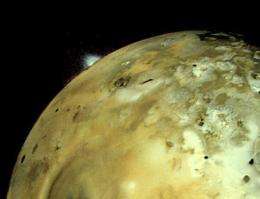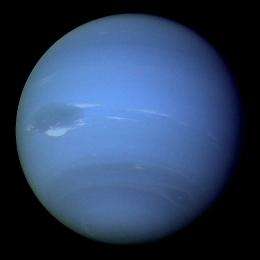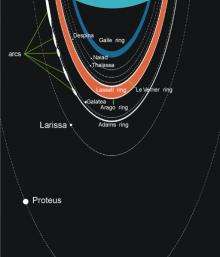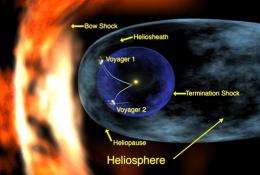Fantastic Voyage

By travelling to the outer solar system, the two Voyager spacecraft allowed us to see amazing details of far-distant planets and moons.
Twenty years ago, Voyager 2 left Neptune behind. The robotic spacecraft had taken advantage of a rare alignment of the outer planets that enabled it to visit Jupiter, Saturn, Uranus and Neptune in a single shot.
Voyager 2 had launched before its sister ship, Voyager 1, on August 24, 1977. Voyager 1 lifted off just a few days later, on September 5, 1977, on a faster trajectory headed for Jupiter, Saturn and the latter’s enigmatic moon, Titan.
Ed Stone, Project Scientist on the Voyager mission says, “We really felt that we were on a journey of discovery - only we had no idea just how successful it was going to be.”
For the Voyager navigation team’s Linda Kelly, Jupiter was the high point of the mission. “The cloud patterns of Jupiter as Voyager 1 approached were visible for the first time in high-resolution, and that had never been seen before. I don't think that any human artist could ever have envisioned what we would see at the planet itself. That set the stage for what was to come -- my discovery of active volcanism on Jupiter's moon, Io.”
Io’s volcanism is at least a hundred times more violent than that of Earth. Kelly recalls Stone’s reaction. “It was so unexpected … a paradigm shift… seeing things that we hadn’t thought about at all, and that turned out to be very characteristic of the rest of the mission.”
There were other discoveries to come. Jupiter’s second moon Europa was covered in a world-girdling crust of ice - frozen as hard as rock. When the Galileo mission later visited Jupiter in the 1990s, scientists learned that this ice protects an ocean of liquid water which potentially could harbor life.
Jupiter’s moon Ganymede - bigger than the planet Mercury - has a tormented and fractured landscape of rock and ice that reminded the team of Earth. The outermost of the four large Jupiter satellites, Callisto, revealed a terrain reminiscent of our own Moon; a fractured, frozen terrain of craters that suggested all geological activity had long since ceased.

After visiting Jupiter, Voyager 1 headed towards Saturn. Voyager 1 discovered that the ring system that encircles the planet is much more complicated than previously thought. As Voyager Imaging Team Leader Brad Smith has pointed out, Voyager 1’s revelations of the complexities of the Saturnian ring system meant that Voyager 2, which was also due to tour Saturn months later, had to be hastily re-programmed en route to investigate this unexpected complexity in detail.
Stone says the ability to re-program the spacecraft on the fly was crucial to the success of the Voyager missions. “By design, we started developing the encounter sequences [between planets]. There were a dozen or so for each encounter.”
At Saturn, Voyager 1’s epic planetary odyssey came to an end. At the time the spacecraft was launched, there was much interest - especially by Carl Sagan - in Titan, the mysterious orange-shrouded moon of Saturn. Earth-based spectroscopic examinations suggested the existence of organic molecules in Titan’s atmosphere. The lure of possibly finding life at the edge of the solar system was too much for the Voyager team to resist, and they decided to have Voyager 1 swoop in for a close look. However, this orbital maneuver meant that Voyager 1 would head up out of the plane of the ecliptic (the orbital path around the Sun) at an angle of about thirty degrees, thereby ending the spacecraft’s planetary encounter days.
The Titan encounter was a bit of a disappointment. As Voyager 1 closed in, the images it collected showed the moon was as featureless as a billiard ball. It would be left to another mission over twenty years later - Cassini/Huygens - to peer through the photochemical haze engulfing Titan and see the complex geology beneath.
Taken together, both Voyager encounters with Saturn showed extraordinary detail of some of Saturn’s other moons: Mimas, Enceladus, Dione, Rhea, and Hyperion. Mimas in particular was scarred by severe impacts, and this gave a clue to the formation of Saturn’s rings. The rings are probably debris left over from a satellite that was destroyed long ago by a collision with another moon. More recently, Cassini’s observations suggest that Enceladus may harbour liquid water.

After Voyager 1 departed the solar system, it was left to Voyager 2 to carry the flag to the outer planets. But when Voyager 2 arrived at Uranus on January 24, 1986, the encounter seemed to be a re-run of the disappointment at Titan. Uranus was a featureless blue ball that at some time in its past had been tipped over so that it orbits on its side.
But the moons orbiting Uranus had interesting geographic features. Voyager 2 tripled the number of known Uranian satellites, and showed that its moon Miranda was a broken, fractured and tormented mess. Smooth plains lay next to ragged scarps and shattered mountain ranges. It was the most varied terrain in the solar system. Scientists now think this terrain resulted from tidal heating when Miranda was in an orbital resonance with the moon Umbriel some time in the past (the current orbital resonance between Jupiter’s moons Io and Europa drives Io’s volcanoes and melts the ice below Europa’s surface.).
Voyager 2’s visit to the Uranus system was fascinating but fleeting. On January 25, 1986, less than 24 hours since it had arrived, the craft left Uranus and headed for Neptune.
Stone recalls, “The challenge of Neptune was the most difficult one we had. We had to know to within one second when we were going to fly over the North Pole of Neptune, and that was a major navigational challenge. We had never delivered that kind of accuracy before. If we were right, it would work, and if we were wrong, then we would have no second chance after twelve years in flight.”

Some feared Neptune would be as bland and featureless as Titan or Uranus. They need not have worried. Neptune was an exquisite deep cyan with its own great spot and fast moving clouds in its atmosphere. There was something almost eerie about Neptune, a lonely outpost at the edge of the solar system as vibrantly colored in its own way as our own beautiful planet.
So far out that the Sun is only a distant speck, Neptune also turned out to have the strongest winds of any planet in the solar system. Wind speeds of the gaseous planets are linked to the amount of energy they receive from the Sun. Jupiter has wind speeds of hundreds of miles an hour, while Neptune’s winds travel at over a thousand miles an hour. Jupiter is closer to the Sun and receives more solar energy, and this heating creates turbulent flow within the atmosphere which can slow linear wind speeds around the planet. Because Neptune receives so little solar energy, there is little turbulence to slow the flow of large volumes of gas once they get moving.
There was another fascinating aspect of Neptune - the possibility that the planet might have rings. From Earth, preliminary detection of rings around Neptune was not confirmed by follow-up observations, but some scientists thought they had evidence for incomplete arcs. Just before Voyager 2 left Neptune, the spacecraft transmitted an image showing a ring-arc in fine detail. It turns out that Neptune is surrounded by five faint rings, and one of these rings contains five arcs, or dense particle clusters within the ring. Scientists think the moon Galatea may play a role in creating these arc clumps.
Neptune's moon Triton is about the same size as the planet Pluto. Its orbit around Neptune is unlike that of all other major satellites in the solar system. Triton orbits in reverse - in a retrograde orbit. This may indicate it didn’t form as part of the process which made the planet Neptune, but instead was gravitationally captured by the planet at a later time.
Voyager 2 found that Triton has the coldest surface that either of the Voyager probes observed in the solar system - at only 40 degrees above absolute zero (-233 C or -387 F), it is so cold that its polar caps are solid nitrogen. Near the poles the Voyager imaging team found geysers spewing liquid nitrogen miles high.
Both Voyagers are now on their way out to the edge of the solar system, where the influence of the solar wind ceases and the phantom wisps of interstellar space take over. Voyager 1 crossed the Termination Shock - where the solar wind slows to sub-sonic speeds - in December 2004. Voyager 2 crossed it in August 2007. At the present time both spacecraft are in the region of the solar system known as the heliosheath, heading towards the edge of the solar system where the interstellar medium takes over (the heliopause).
The encounter is predicted to happen within a few years, although as Tom Krimigis, Emeritus Head of Space Science at Johns Hopkins University points out, “The heliopause… is still a theoretical construct. We still don't know how close we really are to [it]. I think we could be another eight years before we get there.”
How then to summarise Voyager? As Stone observes “I felt that we were all in the tradition of Galileo. He was the first to see the moons of Jupiter and the first to apply an instrument to increase our ability to observe the universe. Voyager is just the latest tool which we as a civilization have managed to devise, and the tool was so powerful that we saw things that nobody had seen before and that nobody had imagined that we could see.”
Source: Astrobio.net, by Richard Corfield


















